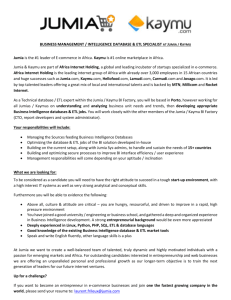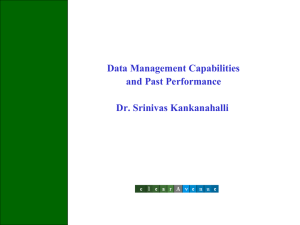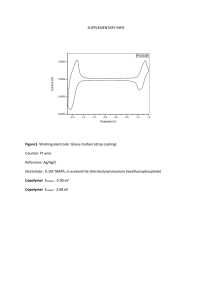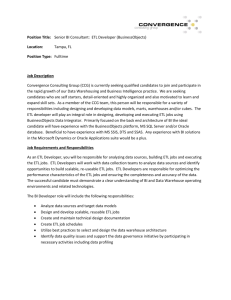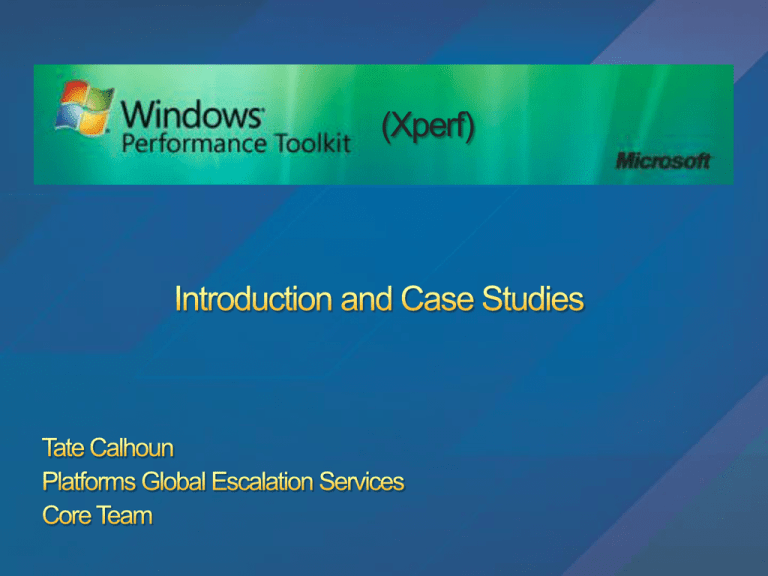
(Xperf)
Trace Capture,
Xperf.exe
Processing, and
Command-Line Analysis
tool
Captures traces, post-processes them for
use on any machine, and supports
command-line (action-based) trace
analysis.
Visual Trace Analysis
tool
Xperfview.exe Presents trace content in the form of
interactive graphs and summary tables.
On/Off Transition Trace
Capture tool
Xbootmgr.exe Automates on/off state transitions and
captures traces during these transitions.
Event Tracing for Windows
ETW documentation in MSDN
http://msdn.microsoft.com/enus/performance/default.aspx
http://go.microsoft.com/fwlink/?LinkId=91917
http://technet.microsoft.com/enus/library/cc732334.aspx#CBS
I've got a DPC issue on this machine to track down further with the NIC :)….15% DPC
time as a constant is not good for performance!
Interesting to note that it matches the CPU Sampling by CPU.
However, we are ~41% idle
What is going on here? Half Idle, Half…
Ah, my backup application at PID 496 is running doing it's thing…
What is going on here? Half Idle, Half…
But what is Outlook doing during all this?
Summary: So I've found a taxing network DPC issue on my machine so I'll go
follow up with my NIC configuration/driver. (turns out disable renable did the
trick) Also, I've seen that I’ve got my backup application querying the file system
here likely indexing by design. Also, I've got more digging to do into Outlook
using the Cswitch stackwalk event (running the trace before the hang).
Addendum: Found two separate hang bugs in Outlook actually where the root
cause of the hangs(with the debugger, I cheated, sorry, I feel bad). The write
stack matched one though!
The situation is that on two different platforms (physical vs. virtual) of stated same build are
displaying two different scheduling behaviors when viewing CPU time for RunScottRun.exe. The
exe “doesn't stay on a processor”…
xperf -on
PROFILE+DISPATCHER+PROC_THREAD+LOADER+HARD_FAULTS+INTERRUPT+DPC+CS
WITCH -maxbuffers 1024
Here is what the "good" trace looks like…We have our Process level view to clone the selection….
Now the CPU Scheduling section. At a high level the problem reported is that
RunScottRun.exe is having trouble getting enough time on a single CPU and we see
context switches...
We can see this at a little bit lower level what is getting to run…
At an even lower level RunScottRun.exe is lower priority, we see SomeService.exe
sneak in here at Pri 9, then back to RunScottRun.exe after Delay Execution.
If you are an Excel wiz :) the data can be exported for another view.
Here's the "good" trace summary/pivot
C:\xperf>xperf -on DiagEasy -stackwalk ProcessCreate+ProcessDelete
C:\xperf>notepad
C:\xperf>xperf -d processcreate.etl
Merged Etl: processcreate.etl
(shows stacks on 7sdk Stack Counts by Type)
C:\xperf>xperf -on FileIO+FILENAME -stackwalk @file.txt
C:\xperf>xperf -d file.etl
Merged Etl: file.etl
C:\xperf>xperf file.etl
(shows stacks with 08 ver, in File IO Section)
C:\xperf>xperf -on DiagEasy+REGISTRY -stackwalk @reg.txt
C:\xperf>regedit
C:\xperf>xperf -d reg.etl
Merged Etl: reg.etl
(shows stacks with 08 ver, in Registry section)
C:\xperf>xperf -on DiagEasy+POWER -stackwalk @power.txt
C:\xperf>xperf -d power.etl
Merged Etl: power.etl
C:\xperf>xperf power.etl
C:\xperf>c:\xperf7sdk\xperf power.etl
(shows stacks with 7sdk Stack Counts by Type)
Xbootmgr.exe! It can trace boot, hibernate, standby, shutdown, rebootCycle
performance.
Heap and VirtualAlloc
tracing in user mode...
The toolkit: http://msdn.microsoft.com/en-us/performance/default.aspx
The forum: The Windows Performance Toolkit Forum
Remember to check the Windows 7 SDK for the cool Stack Counts by Type
section and other improvements!
Can I use Performance Analyzer on Windows XP or Windows Server
2003?
Unfortunately, the answer is 'no'. While Windows XP and Windows Server 2003
do support collection of ETL traces, these OSes do not contain instrumentation
for most of the events needed by Performance Analyzer (PA). You need
Windows Vista or later OS to use PA. An example of crucial instrumentation
added in Vista is stack walking. Performance analysis without stacks can be an
extremely daunting task that only a true expert with access to source code can
tackle.
With the Windows Vista release, Microsoft has really taken the OS to next level
in terms of system diagnosibility and a lot of the analysis based on this
instrumentation isn't feasible on Windows XP/Server 2003 ETL traces.
How do I find out the time span of the trace my customer collected to
correlate with other data? (-a tracestats)
How to enable stackwalking on x64 systems?
x64 ETW stackwalking is only supported on Windows Vista SP1, Windows
Server 2008, and above, and requires setting a certain registry value (see
below) to 1 and rebooting the machine ( so that Windows kernel picks it up).
HKLM\System\CurrentControlSet\Control\Session Manager\Memory
Management
DisablePagingExecutive 1
© 2009 Microsoft Corporation. All rights reserved. Microsoft, Windows, Windows Vista and other product names are or may be registered trademarks and/or trademarks in the U.S. and/or other countries.
The information herein is for informational purposes only and represents the current view of Microsoft Corporation as of the date of this presentation. Because Microsoft must respond to changing market conditions,
it should not be interpreted to be a commitment on the part of Microsoft, and Microsoft cannot guarantee the accuracy of any information provided after the date of this presentation.
MICROSOFT MAKES NO WARRANTIES, EXPRESS, IMPLIED OR STATUTORY, AS TO THE INFORMATION IN THIS PRESENTATION.


